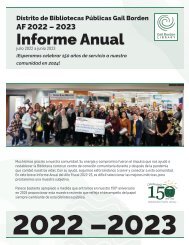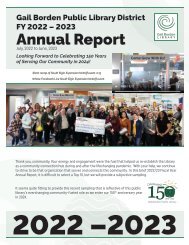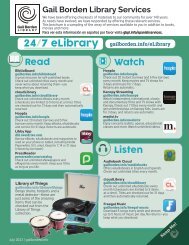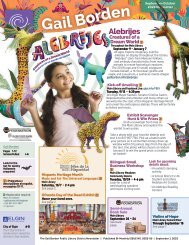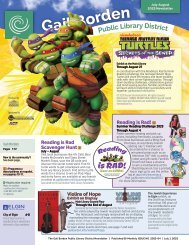September October Newsletter 2021
- No tags were found...
You also want an ePaper? Increase the reach of your titles
YUMPU automatically turns print PDFs into web optimized ePapers that Google loves.
<strong>September</strong>-<strong>October</strong><br />
City of Elgin<br />
<strong>2021</strong> <strong>Newsletter</strong><br />
Conservation@Home is the ultimate everyone-can-do-something<br />
program offered by The Conservation Foundation. It starts with you<br />
making some earth-conscious choices in your home landscaping.<br />
Replace some turf grass with beautiful and drought-resistant native<br />
plants, maybe install a rain barrel or two and reduce or eliminate your<br />
chemical use. Whether you are starting from a grass lawn or have<br />
existing natural areas on your property, the Conservation@Home<br />
program can help you make your yard more attractive to wildlife and<br />
retain precious rainwater. Steps you can take include planting native<br />
plants that support butterflies and other pollinators, installing a rain<br />
garden and removing plants introduced from Europe and Asia. Not only<br />
will you be contributing to a healthier environment, you can spend<br />
valuable outdoor time as a family, and you’ll get to enjoy nature’s<br />
ever-changing cast of characters right outside your window.<br />
Beautifying your yard while conserving water and creating a habitat for<br />
wildlife can be easy and rewarding! Adding native plants can help you<br />
save money, mow less, see more birds and butterflies and enjoy a<br />
functioning yard with fewer problems and less effort.<br />
The Conservation Foundation is happy to offer some advice along the<br />
way, free of charge. With the right selections, you can easily incorporate<br />
native plants into existing or new gardens.<br />
Why Natives?<br />
Conservation@Home<br />
Once you’ve created an attractive and functional yard that conserves<br />
water and provides habitat for birds, butterflies and other beneficial<br />
wildlife, you deserve some recognition for your efforts! The<br />
Conservation Foundation can certify your yard as an<br />
environmentally-friendly landscape with a Conservation@Home sign.<br />
Then your neighbors may get curious and want to know learn about the<br />
program. Before you know it, yard by yard, you’ve brought more nature<br />
to your neighborhood. If you are interested in making your property a<br />
Conservation@Home certified landscape, visit<br />
theconservationfoundation.org/conservation-home/.<br />
At the core of environmentally friendly landscapes is the use of native<br />
plants, the absence of fertilizers or pesticides and smart water use.<br />
Native plants are those species that were thriving locally when the<br />
first settlers arrived. These plants have evolved over thousands of<br />
years to survive the soils and seasonal conditions of cold, rain and<br />
drought of our northern Illinois climate.<br />
As the country was settled, more and more land was converted from<br />
native landscape to farm fields, cities, roads and suburban<br />
development. Plants that have historically been planted as<br />
replacements have been introduced from outside our local region –<br />
usually from Europe or the Far East. This has broken the dependent<br />
relationships that evolved over thousands of years between native<br />
plants and the birds and animals that are dependent on them directly<br />
or indirectly for their survival. The decline of many species of birds<br />
and fewer butterflies in our gardens is linked to these changes.<br />
Loss of open space and wildlife habitat, degradation of what remains,<br />
and dirty stormwater runoff are the leading causes of environmental<br />
problems in our developed areas. By replacing some of this lost<br />
habitat in our yards and conserving rain water before it runs into our<br />
roads, we can reduce some of the negative impacts of development,<br />
have cleaner water in our neighborhoods and enjoy a better quality<br />
of life. These actions also restore the food sources (in the form of<br />
native plants) that have been<br />
lost to our pollinators as land<br />
has been developed over the<br />
years. Adding native plants –<br />
including trees and shrubs – to<br />
our gardens will significantly<br />
help make our gardens<br />
productive and full of life!<br />
GAILBORDEN.INFO D<br />
CITYOFELGIN.ORG | 311 (OR 847-931-6001)<br />
D






